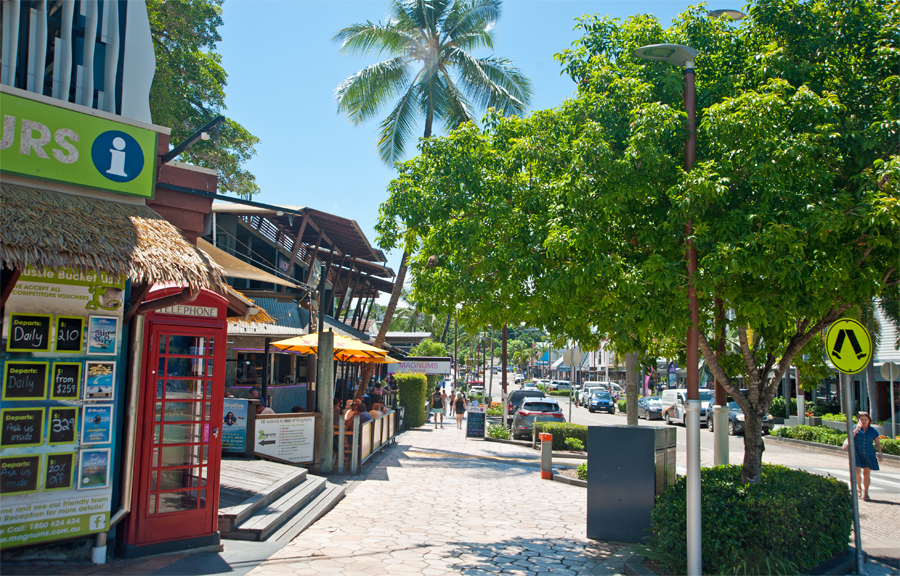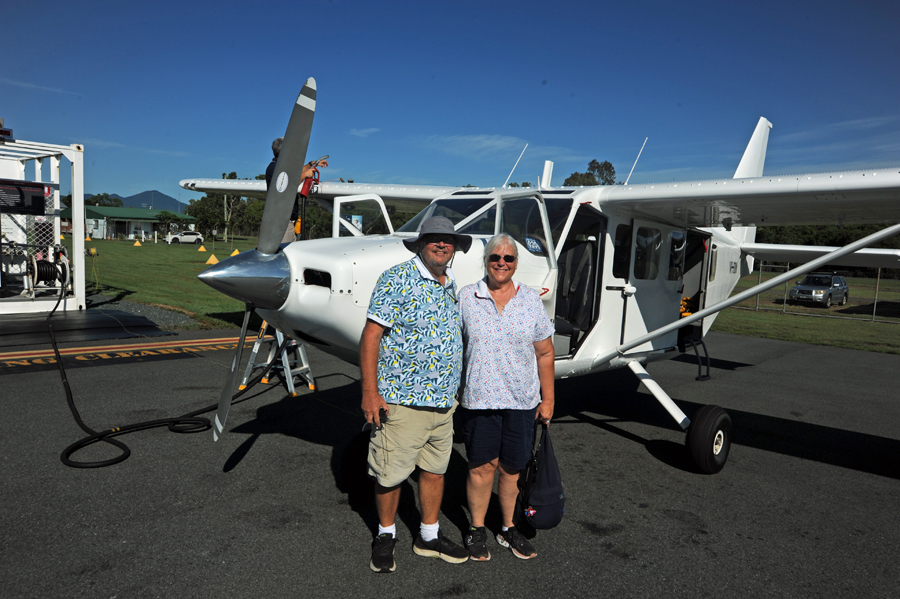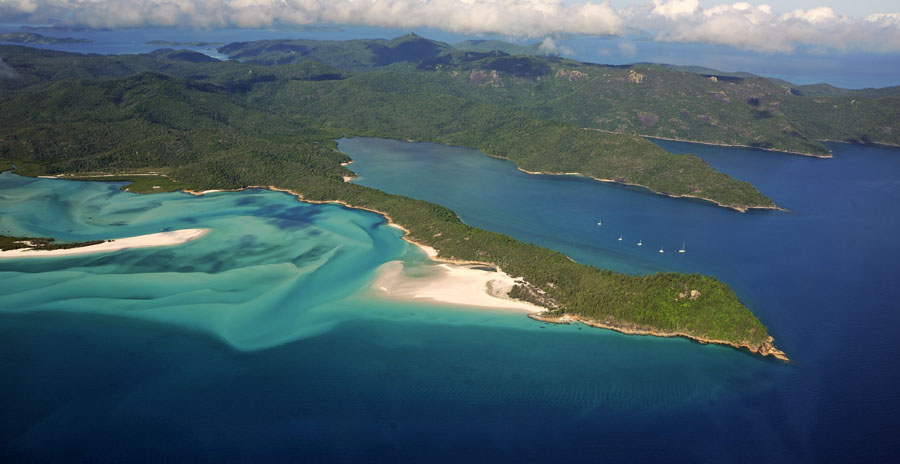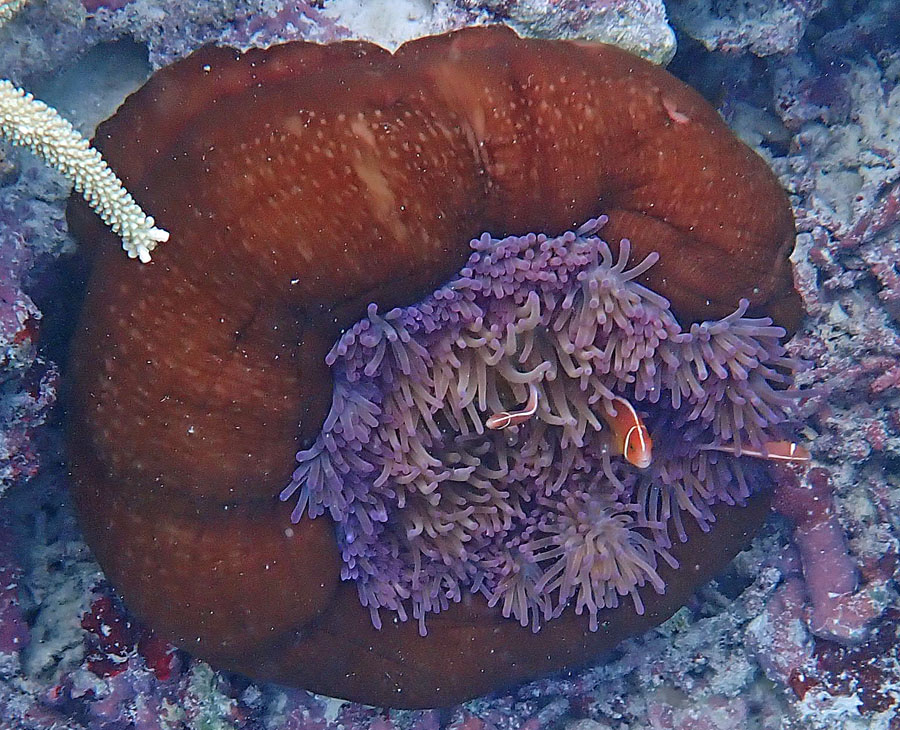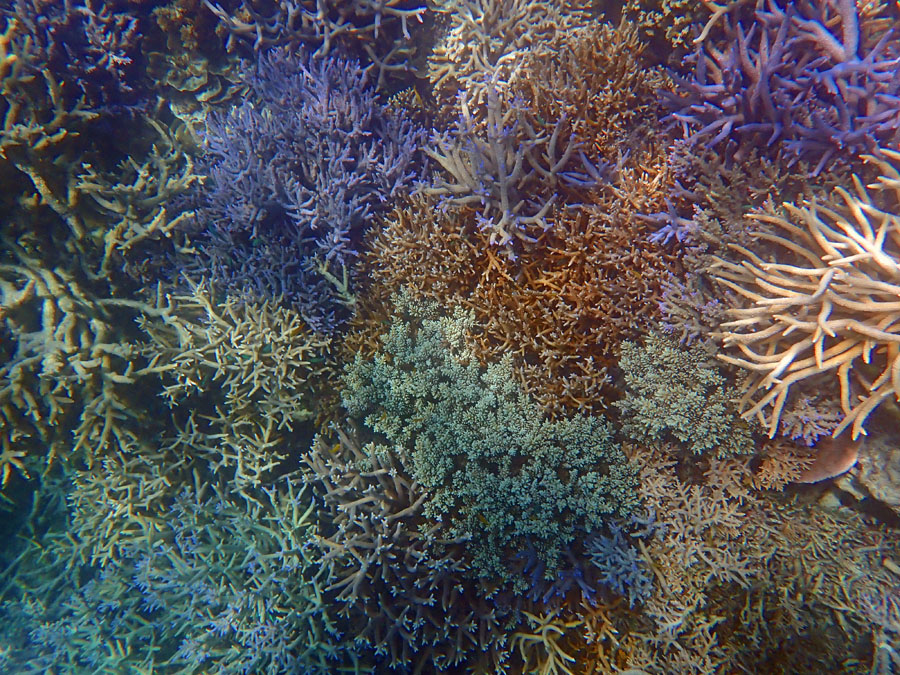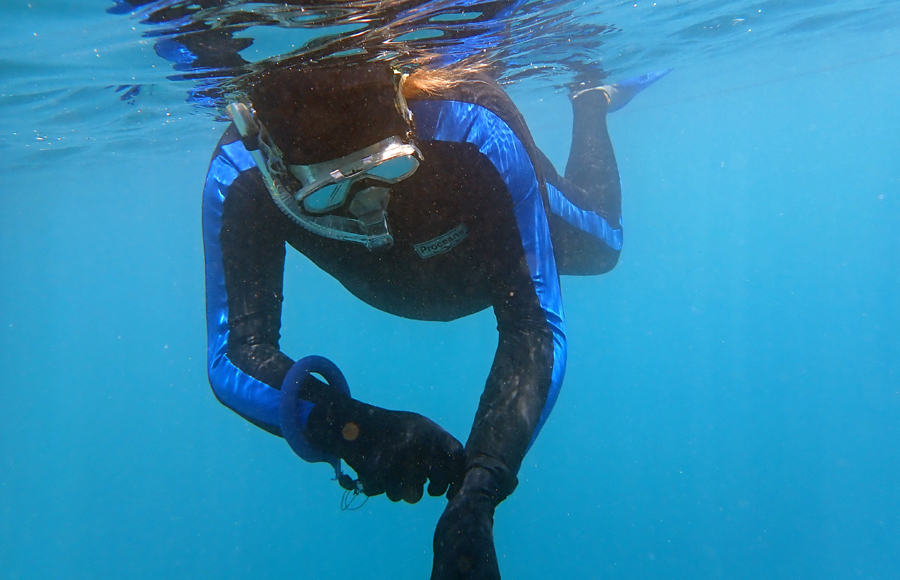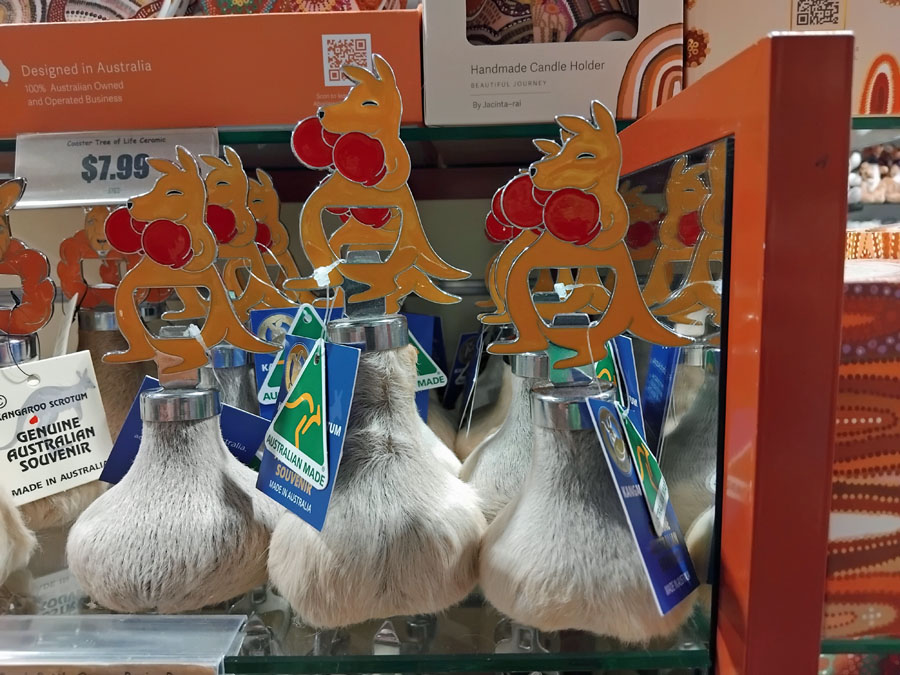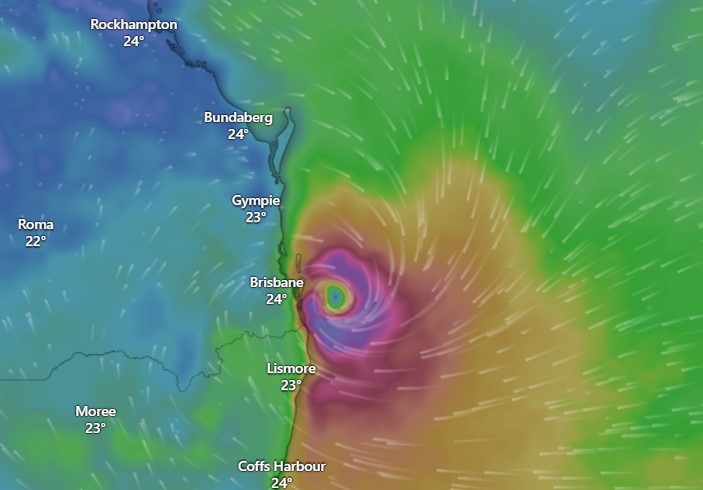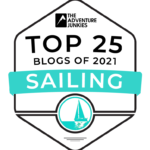After a fabulous couple of days watching Kangaroos on the beach, we continued our journey northward. Our next stop is Airlie Beach. Airlie Beach is a tourist trap. Not that there is anything wrong with that. What is there to do there? Tourism stuff.
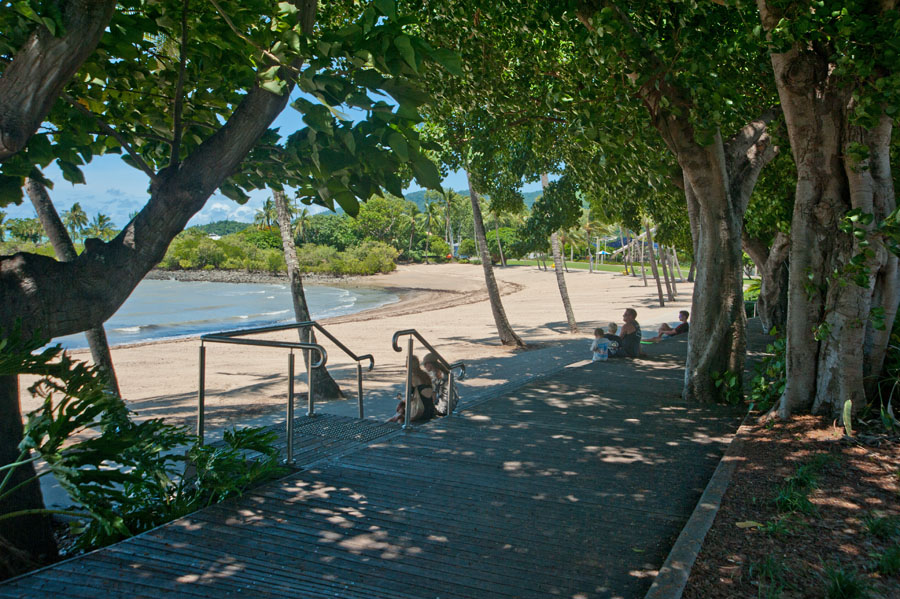
People sit in the shade to avoid the blistering sun. There really is a beach in downtown Airlie Beach
Reasons for a tourist to go there: First, it has access to the Whitsunday Islands. The Whitsundays would be the equivalent of the Bahamas to Americans. Tons of islands with deserted beaches and not many people. Secondly, it is a point where the Great Barrier Reef is accessible. Thirdly, the town’s main street, Shute Harbour Road, is lined with cafes, restaurants, bars, and shops, making it a perfect spot for leisurely strolls and enjoying the local cuisine, which we did indulge in.
All of these things were of interest to us. The question looming is how to get to the Great Barrier Reef when we left the Puffster back at the marina and arrived by car. As you would imagine, being a tourist destination, there are tons of possibilities that are presented. There are boats, helicopters, and airplanes all willing to give tours. But, we wanted to snorkel/dive the reef for the ultimate experience.
We are quite a bit further north in Airlie Beach. The town sits inside the tropics and is prone to the occasional cyclone. Hence, the Puffster is way south in a safer zone (more on this later). It is cyclone season now, summer. And, with cyclone season comes rain. Massive amounts of rain.
We rented an awesome condo via AirBnb for a week. It came with a massive TV which I swear gave me a suntan. For us, this was a big part of the trip. We so rarely have the opportunity to stay in a real house with a full kitchen, a real shower with unlimited hot water, a king-size bed, and real furniture. To top it off, the location was perfect putting us very close to town and the shops.
Our first adventure is a plane ride out to the reef. We had reservations for a date later in the week but looking at the weather, things were about to turn to shit. We managed to rebook and got ourselves an early morning flight on our second day when the skies were clear. A good move on our part.
If you Google just about anything related to Airlie Beach, you will quickly notice a coral reef that is a part of the Great Barrier Reef shaped like a heart. The slogan “Airlie Beach – Heart of the Reef” is everywhere. Well, if you’ve come all this way, you gotta go see it, right? We booked a tour on a plane to take it all in.
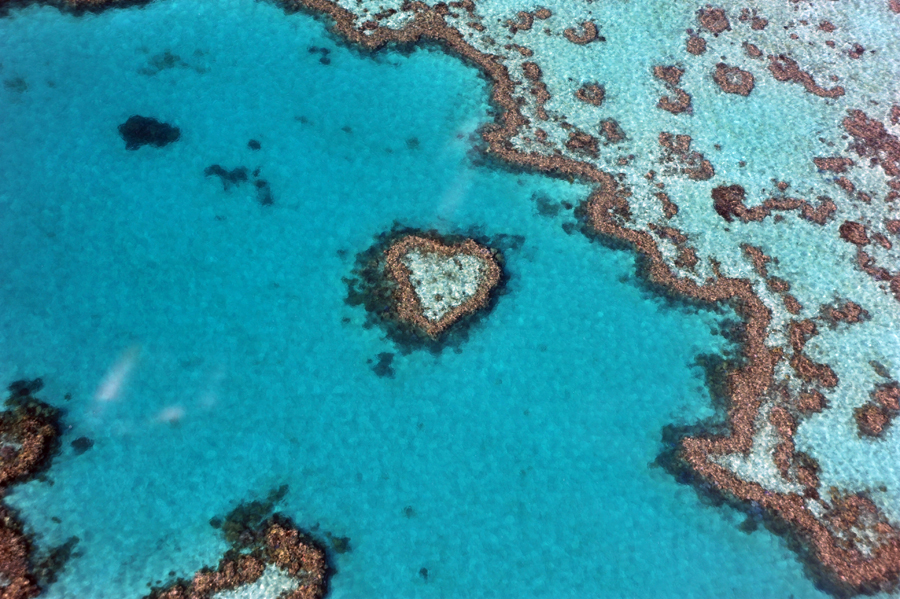
We get a bird’s eye view of Heart Reef located in Hardy Reef, part of the Great Barrier Reef close to The Whitsundays.
We also flew over a highly photographed area. This area of the Whitsundays known for its shifting sands is Whitehaven Beach, located on Whitsunday Island. Whitehaven Beach is famous for its stunning white silica sand, which shifts and changes with the tides and weather. The sand is incredibly fine and pure, composed of 98% silica, and its shifting nature contributes to its unique, ever-changing appearance. The pilot of the plane said that every day the pattern of the sand in the water looks different. He could personally attest to this as a person who sees it just about every day. He also told us, the silica there is so pure, it was used in the lenses of the Hubble Space Telescope. This beach is often regarded as one of the most beautiful in the world
For our trip to the Great Barrier Reef, we decided to do an ultra-touristy thing that is normally so outside of our box. We decided to take a ferry out to a fixed pontoon on Hardy Reef. Our ferry departed from the harbor at 8 am and made a stop at Hamilton Island.
Hamilton Island is a popular place for spa hotels and rental properties. It’s kinda pricy. It has a marina – too pricey for us to consider. It is one of the few places in the world with no cars. The island is car-free! Due to its being so compact, the primary modes of transport are golf carts and bicycles. Just about every home or hotel room is built to have a view of the Coral Sea.
The total time of the boat ride out to the reef was about 2 hours covering a distance of about 100 km (60 miles +/-). After off-loading and loading supplies and passengers, we departed Hamilton Island for the remaining hour-plus ride out to the reef. The hour passed quickly since the crew of the boat were selling services on the pontoon. Most were hard sells for diving tours. We did bite, but not on a diving tour. We opted to take a small boat with a group of six to a part of the reef located away from everyone else. So glad we did this. Our experiences have taught us when a lot of people are in the water, the fish run for their lives.
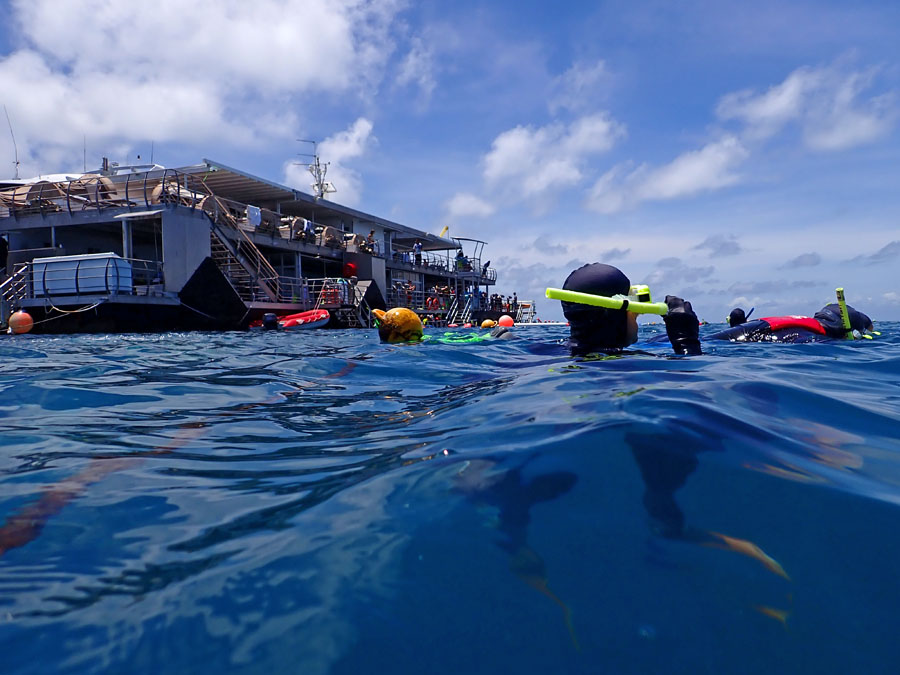
At the end of our snorkel, we drift back to the Reef World pontoon. Very glad we spent a little bit extra to get away from the crowd.
The boat dropped us off and we drifted with the current back to the area of the pontoon. We were accompanied by a guide. A guided snorkel tour is not a good idea. If you wish to be able to hear what the guide is saying or pointing at, you need to have your face out of the water. With ones face out of the water, you can’t see anything in the water. Kinda defeats the purpose of being there. While it wasn’t even close to some of our best snorkeling sights we have found over the years, we can now boast we have seen and swum at the Great Barrier Reef.
I almost forgot to mention, while swimming here people need to wear stinger suits. The area has jellyfish that will kill you. I’m not kidding about the killing. Australia loves to brag about how they have the most animals on the planet that can kill humans quickly and efficiently. This area is prone to Box Jellyfish. Even if you don’t die, its sting can cause extreme pain, paralysis, and heart failure. In the ocean, we are way down on the food chain. Thankfully, the Great White sharks decided to stay away this day.
As I mentioned earlier, we expected the weather to change. As far as our outdoor activities, our timing to the area was perfect. We managed to get all the fun things in that we wanted to do, and then for the last couple of days it rained. It rained pretty hard. In fact, it never really stopped raining. Shortly after we left, the news showed flooding in the area.
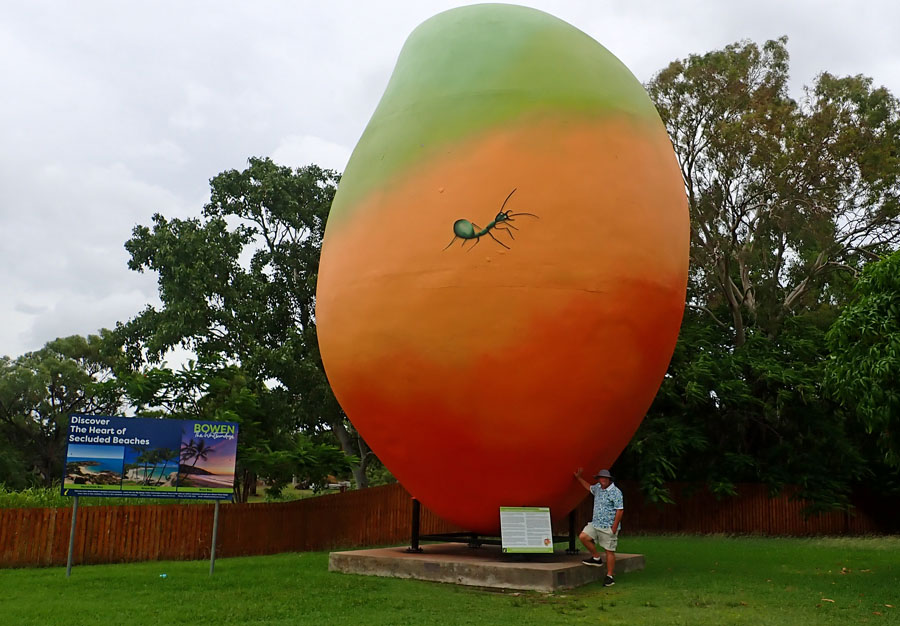
In-between rain showers we popped up to Bowen to see the giant mango (mentioned as a shit thing to do in a shit town – keep reading the post)
The host of the AirBnB is a sweet Irish lady and she sent us a couple of texts with things to do in the area while it’s raining. Cindy let her know that we were perfectly content sitting about the condo for the last couple of days since living in a building is a treat for us. In between rain showers, we popped into town for lunch and to purchase a couple of souvenirs.
We had a couple of big anniversary dates hit us recently. One was while we were in Fiji. We wanted to buy something to mark the occasion. But, to be perfectly honest, we never found anything in Fiji we felt like putting on a shelf and looking at for the rest of our lives. We scrubbed the idea and decided to wait until we moved on. In New Caledonia, we did some shopping but still failed to find an item that screamed “buy me”.
As luck would have it, Cindy found the perfect shop. It is a gallery featuring art by Australian Foot Young, based at Hamilton Island. He has sculpted mostly in marble originals over 700 different works ranging from a selection of jewellery-sized pieces to large outdoor works of monumental proportions. Most of his works are available as marble or bronze sculptures. Picking a marble sculpture is an ordeal since between works the color variance is notable. We purchased a couple of items: a marble sculpture of a whale breaching the waves and a bronze of a Koala in a tree.
Sadly, we won’t see the whale for a little while since it is too big and too fragile for the boat. We shipped it to a friend in the USA to hold for us. I can’t help but wonder when we’ll see it again. The koala is looking at me right now.

The rain as we departed Airlie Beach was quite intense but gave way to sunshine as we got further south
Our drive back to the Puffster was uneventful. We felt pretty good about getting some checkmarks for things on our list, like seeing Kangaroos on the beach and swimming the Great Barrier Reef. We still need to see a koala bear in the wild. We eagerly anticipated the weekend since we now have a new Friday activity in the marina and are excited to share details of our latest adventure.
We consider ourselves very fortunate to have been inducted into a group of local sailors in the marina where we are keeping Cream Puff. The group consists of about 10 locals who meet for drinks every Friday. It’s casual. You make it if you can, if not then there is always next week. They rotate boats with the host providing a few snacks, and everyone brings what they wish to drink. These are awesome people.
Let me tell you a quick story about one of them, Karen. When we first arrived in Australia, we cleared customs and immigration and made our way to the marina where we are now. On our second day here, we planned to purchase SIM cards at a local shopping center and then pick up a long-term rental car for our duration here. I spent some time on the net looking at buses and trains to get us where we needed to go. While on the boat, we had said hello to Karen as she walked past a couple of times. Really nothing more than just a polite hello.
On the morning when we planned to get the card and car, we walked to the bus stop just outside the marina gates. While waiting for the bus, a car stopped and I recognized the lady driving as the same person we’d said hello to on the dock. She asked us if we were the same people who had just arrived. We confirmed. She then asked where we were heading. We told her we needed to buy SIM cards at Kippa Ring shopping center about 5 km away (3 miles about 10 minutes). She offered a ride. I asked if she was going that way. She was actually going the other way and insisted on taking us.
Not only did she take us to the shopping center, but this super kind person also made a point of dropping us at the end where the cell phone shop was located. Cindy and I both couldn’t believe how someone went out of their way to help out perfect strangers. This act of kindness has really set the tone for things to come in Australia.
When we arrived at the rental car facility, we chatted with the owner who also happened to be a boater. We started talking about weather services we use and he had lots of questions. During the conversation, he asked about our plans and where we planned to travel in Australia. At that time, about the only plan we had was that we wanted to travel north to Airlie Beach and perhaps up to Cairnes. He told us whatever we do, don’t go to Townsville City unless we wanted our rental car stolen.
I asked if Townsville City is a rough town. He said it wasn’t but 4 out of the last 5 cars they had stolen happened in that town. I made a sort of mental note and never thought about this again. That is until the evening we were with the group and they asked us about our recent trips. For some reason, I mentioned the conversation between the rental agency owner about taking the car to Townsville City and what he had said about cars being stolen there. Karen started to laugh so hard I thought she might pee herself.
When she finally stopped laughing, she said her sister lives in Townsville City. For a second, I thought, oh shit. I hope I haven’t immediately offended all these nice people by repeating something about Australia. Thankfully, this wasn’t the case. A part of why she was laughing so hard is because Townville is well know for being a “shit” town. Karen said there is even a Facebook page called Shit Towns of Australia.
I looked up the group, and sure enough, it is full of crazy people who do weird things. One of my favorites was a guy who made the news for being arrested. His crime was that he stole a mailperson’s vehicle to go home and get a beer. As I scroll down the page enjoying stories from shit towns and crazy events, I came across a banner post announcing that Townsville City was Australia’s shit town of the year for 2024. And, the icing on the cake, this wasn’t the first time they had won this prestigious award. Townsville City, Australia, is now a three-time winner of the brown crown following triumphs in 2021 and ’22.
Remember how I told you that animals in Australia like to kill people? Bill, another member of our group, recently knew a chap who had an encounter with a blue-ringed octopus. It bit him on the thumb. There is no antidote for these critters and soon after the bite, a matter of hours, he died. Despite their small size, blue-ringed octopuses are considered one of the most dangerous marine animals.
As he is telling this story, I think about our encounters with octopi over the years. I wonder how you can tell if it is a blue-ringed octopus when they can change their colors in an instant. I later read they change to blue rings as a final warning. Sort of an “oh crap” moment for the person hassling it. Normally, when calm, they appear a dull brown or yellowish, which helps it blend into its surroundings. Note to self: Stay away from ANY octopus from now on.
Now, do you remember the part above about the Puffster being down near Brisbane to be safely away from cyclones? As I write this, we are dealing with a direct hit from Cyclone Albert. The eye was forecasted to go right over Cream Puff. And, that forecast turned out to be correct.
A cyclone (also known as hurricanes or typhoons, depending on the region) this far south on the Australian coast is a very rare thing. The last one to hit Brisbane was over 50 years ago. Aren’t we lucky that we get to have one now? When the forecast first came out, most of the sailors locally shrugged it off and expected an updated forecast to predict a turn more southeast toward New Zealand. But, this never materialized. The marina where we are located put into place their level orange emergency plan. The next level would have forced a mandatory evacuation of all boats.
About 8 boats in the marina, including us, had people who decided to stay aboard. All of our Australian friends decided to get hotels a little inland. I can’t blame them. Staying aboard is not a decision we make lightly. We watched the updates intensely and were ready at a moment’s notice to run for the car and head for the hills, leaving the Puffster to ride it out. We even moved the car outside of the gated lot since the gate is opened with a fob, meaning if the power goes out, the car is in jail stranding us.
A couple of things here used up some of our good karma points. First, the storm stalled a little bit before coming ashore and was downgraded to a Cat 1 storm. Still nothing to sneeze at. But, better for us than a Cat 2. The other good thing was the eye passing right over us. Had it passed north of us coming in, we would have felt the brunt of the storm since the lower southwest side has much more intensity. This is opposite to storms in the northern hemisphere that rotate counterclockwise (or anticlockwise) because of the Coriolis effect. In this case, the higher winds are on the northwest sides. An interesting tidbit: A cyclone or hurricane has never crossed the equator.
We’ve experienced higher winds than we did in this storm out of the ocean. If you recall, during our passage recently to New Caledonia, on our third night we got hammered by sustained 35-knot winds with gust to 45-50 knots. The big difference is that out on the ocean, we don’t have to worry too much about the neighbor’s boat or things not secured flying about the marina. Once the eye passed, we had higher winds from the back side of the cyclone. For about 24 hours, we were pounded with rain and had winds of 30-40 knots steady with the occasional gust to 50 knots. There is a lot that can go wrong inside a marina during a storm. Thankfully, nothing did, and all is okay.
We’ve been back from our trip for a couple of weeks and have been rather busy prepping the boat. Thus, the reason this post is a little slow reaching you. I am finishing this up as the last of the cyclone moves away. As you can imagine, this created a bit of an angst factor.


